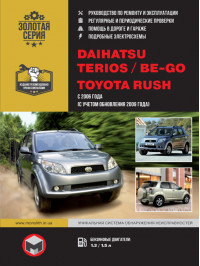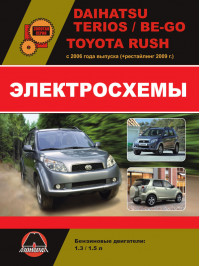Information on repair and maintenance of Toyota Rush cars electronically
Toyota Rush is an SUV based on the Daihatsu Terios, produced since 2006. The car is considered a sister model to the Daihatsu Be-Go and is the successor to the Toyota Cami.
Toyota Rush, introduced in the Japanese domestic market in 2006, is a 5-door mini SUV. This car was developed in collaboration with Toyota's subsidiary, Daihatsu, which is 51% owned by Toyota. Toyota Rush is produced under two different brands for the Japanese market: Toyota Rush and Daihatsu BeGo. Both options differ only in emblems and are sold in both Toyota and Daihatsu showrooms.
This model replaced the second generation Toyota RAV4. The introduction of the third generation RAV4 in 2006 saw the Toyota Rush (and Daihatsu BeGo) fill a niche market by providing a compact and convenient option for buyers.
Features of the Toyota Rush may include compact dimensions suitable for city driving, as well as some SUV characteristics, such as high ground clearance and ability to navigate uneven terrain.
The first generation Toyota Rush (or Daihatsu BeGo) seats a maximum of five people and comes with a new generation 1.5-liter 3SZ-VE petrol engine, which was developed by Daihatsu specialists. This engine is also used in other models of both brands, such as Daihatsu Coo, Daihatsu Boon, Daihatsu Mira, Toyota Vitz (since 2005), Toyota bB, etc. However, in Toyota Rush (Daihatsu BeGo) it is located longitudinally, unlike others vehicles where this engine is mounted transversely.
Characteristics of the 3SZ-VE engine:
- volume - 1.5 liters;
- configuration - 4-cylinder in-line;
- gas distribution - two camshafts, 16 valves;
- maximum power - 109 hp at 6000 rpm;
- maximum torque - 14.4 kg/m at 4400 rpm
In markets in Europe, South America and the Middle East, the Toyota Rush (Daihatsu BeGo) is sold under the name Daihatsu Terios II. In other countries, including Japan, this car is also available with 1.3 and 1.5 liter engines.
The main competitors of the SUV are the Suzuki SX4 and Suzuki Jimny. Currently, the Toyota Rush is only sold in Japan, Indonesia and Malaysia. An attempt to introduce this model in Africa failed.
The main features of the SUV include:
- traction control system with self-locking differential LSD in the rear axle (for all-wheel drive version);
- vehicle stability control system VSC (Vehicle Stability Control);
- DAC and HAC systems to help start and stay on hills and slopes;
- sporty interior style with automatic air conditioning and Plasmacluster Ions air purification technology;
- Active Winter Pack with cold-weather options including heated windows and mirrors, heated seats and rear fog lights.
It is also noted that the all-wheel drive version of the Toyota Rush is available in eight body colors, including Titanium Gray metallic.
In 2017, the second generation Toyota Rush was officially introduced in Indonesia. The car is built on the platform of the Daihatsu Xenia compact van, which is also known as the Toyota Avanza. One of the features of the Toyota Rush is its frame design, rear-wheel drive and ground clearance of 220 mm. Options include a 1.5-liter petrol engine producing 105 horsepower. The engine can be paired with a 5-speed manual transmission or a 4-speed automatic. The drive can be rear-wheel drive, although all-wheel drive versions are offered in some countries.
The SUV is equipped with various modern technologies and options, including ABS, directional stability, and brake force distribution systems. The interior of the car is equipped with air conditioning, a touchscreen infotainment system, an electric sunroof and parking assistants. The engine is started from a button, which adds an element of modernity to driving.
Our website provides the opportunity to read, buy and download repair books and operating instructions for Toyota Rush in PDF format for free. After purchasing, the book can be downloaded to your smartphone or tablet so that it is always at hand at the right time. In the repair manual you will find answers to various questions:
- how to repair the chassis;
- how to change the oil in a gearbox;
- how to identify and eliminate a malfunction of the power system;
- what is the structure of the electrical equipment of the car;
- what are the causes of engine malfunctions, etc.
This manual may be a useful tool for Toyota Rush owners who want to repair their own take care of your car and carry out repair work. If necessary, you can separately purchase Toyota Rush electrical circuits in electronic form, the use of which can be especially useful when repairing the vehicle's electrical equipment.




